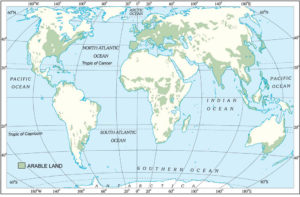1. Answer the following questions.
(i) What is agriculture?
Ans. Agriculture is a primary activity. It includes growing crops, fruits, vegetables, flowers and rearing of livestock.
Two-thirds of India’s population is still dependent on agriculture.
(ii) Name the factors influencing agriculture?
Ans. Agricultural activity is concentrated in those regions of the world where suitable factors for the growing of crops exist. Those factors are:- Favorable topography of soil and climate.
(iii) What is shifting cultivation? What are its disadvantages?
Ans. Shifting cultivation:- A plot of land is cleared by cutting the trees and burning them. The ashes are then mixed with the soil and crops like maize, yam, potatoes and cassava are grown. After the soil loses its fertility, the land is abandoned and the cultivator moves to a new plot. Shifting cultivation is also known as ‘slash and burn’ agriculture.
Disadvantages of Shifting cultivation:-
- It can easily lead to deforestation because when soil fertility is exhausted.
- Shift farming can easily cause soil erosion and desertification.
- It easily leads to loss of biodiversity.
(iv) What is plantation agriculture?
Ans. It is a commercial farming where single crop of tea, coffee, sugarcane, cashew, rubber, banana or cotton are grown. Large amount of labour and capital are required. Development of a transport network is essential for plantation agriculture.
(v) Name the fibre crops and name the climatic conditions required for their growth.
Ans. Jute and cotton are fibre crops. They grow well on alluvial soil and requires high temperature, heavy rainfall and humid climate. This crop is grown in the tropical areas.
2. Tick the correct answer.
(i) Horticulture means
(a) growing of fruits and vegetables (b) primitive farming (c) growing of wheat
(ii) Golden fibre refers to
(a) tea (b) cotton (c) jute
(iii) Leading producers of coffee
(a) Brazil (b) India (c) Russia
3. Give reasons.
(i) In India agriculture is a primary activity.
Ans. Agriculture is a primary activity because two-thirds of India’s population is still dependent on agriculture. Agriculture and its allied activities act as main source of livelihood for more than 80% population. One-third of our National income comes from agriculture.
(ii) Different crops are grown in different regions.
Ans. Agriculture has developed at different places in different parts of the world. Agricultural activity is concentrated in those regions of the world where suitable factors for the growing of crops exist. Those factors are:- Favorable topography of soil and climate.
4. Distinguish between the followings.
(i) Primary activities and tertiary activities
Ans. Primary activities include all those connected with extraction and production of natural resources.
Agriculture, fishing and gathering are good examples. Secondary activities are concerned with the processing
of these resources. Manufacturing of steel, baking of bread and weaving of cloth are examples of this activity.
(ii) Subsistence farming and intensive farming.
Ans. Subsistence farming:- This type of farming is practiced to meet the needs of the farmer’s family. Traditionally, low levels of technology and household labour are used to produce on small output. Subsistence farming can be further classified as intensive subsistence and primitive subsistence farming.
Intensive farming:- In this type of farming the farmer cultivates a small plot of land using simple tools and
more labour. Climate with large number of days with sunshine and fertile soils permit growing of more than one crop annually on the same plot. Rice is the main crop. Other crops include wheat, maize, pulses and oil seeds. It is practiced in thickly populated areas of the monsoon regions of south, southeast and east Asia.

Thanks for the question answer session , Sir!
I would like to say that you provide the rest chapters 5th and 6th solution.
I would be highly obliged.
Nice guidance sir. Thank you so much
Thanks for this question/answers